Oregon Grape Mahonia × media 'Underway'

ABOUT
Mahonia × media 'Underway', commonly known as Mahonia, is a striking plant with an attractive appearance. It features compound leaves that have multiple leaflets arranged on either side of a central stem, contributing to a feathery, albeit spiky, look. The leaflets themselves are leathery to the touch, with a glossy, deep green hue that can add a touch of elegance to any garden setting. Come winter, the interest in Mahonia continues as it produces clusters of vibrant yellow flowers, which are tightly packed together in racemes that arch gracefully. These blossoms not only brighten up the garden during the colder months but also emit a delicate fragrance that can be quite appealing. Following the flowering period, the plant often bears dark blue to purple berries that provide a striking contrast against the foliage and can attract various birds and wildlife to the garden. Mahonia 'Underway' is a cultivated variety that is appreciated for its robustness and ornamental value, making it a popular choice for landscapers and gardeners seeking a plant with year-round visual interest. Its textured leaves, stunning flowers, and attractive berries provide a multi-seasonal display that makes it a distinguished addition to any landscape design.
About this plant
 Names
NamesFamily
Berberidaceae
Synonyms
Oregon Grape, Grape Holly
Common names
Mahonia x media 'Underway'.
 Toxicity
ToxicityTo humans
The Oregon grape is not generally considered highly toxic to humans, but its berries and other parts may contain alkaloids that can cause mild stomach upset if ingested in large quantities. The consumption of large amounts of berries can lead to symptoms such as nausea, vomiting, and diarrhea. It is always advisable to avoid eating any parts of ornamental plants due to potential adverse effects.
To pets
The Oregon grape can be toxic to pets if ingested. The berries and foliage contain alkaloids such as berberine, which can cause gastrointestinal upset in dogs and cats. Symptoms of poisoning in pets may include vomiting, diarrhea, and lethargy. If you suspect your pet has eaten any part of this plant, it is important to consult your veterinarian.
 Characteristics
CharacteristicsLife cycle
Perennials
Foliage type
Evergreen
Color of leaves
Green
Flower color
Yellow
Height
10 feet (3 meters)
Spread
5 feet (1.5 meters)
Plant type
Shrub
Hardiness zones
7
Native area
Cultivar
Benefits
 General Benefits
General Benefits- Attractive Foliage: Vivid, evergreen leaves provide year-round color and texture to gardens.
- Winter Flowers: Yellow blooms in late autumn to winter add brightness in the otherwise dormant garden.
- Drought Tolerance: Once established, it's quite hardy and can tolerate periods of low water availability.
- Low Maintenance: Requires minimal pruning and can thrive with basic garden care.
- Wildlife Friendly: The flowers attract pollinators, while the berries can provide food for birds.
- Architectural Structure: Upright growth habit and distinctive foliage offer architectural interest to landscapes.
- Shade Tolerance: Adaptable to a variety of light conditions, including partial shade.
- Barrier Planting: Its spiny leaves make it good for planting as a deterrent along boundaries.
 Medical Properties
Medical PropertiesThis plant is not used for medical purposes.
 Air-purifying Qualities
Air-purifying QualitiesThis plant is not specifically known for air purifying qualities.
 Other Uses
Other Uses- Winter interest in gardens: Mahonia × media 'Underway' is often planted for its vibrant foliage and bright winter berries, adding color to gardens during the colder months.
- Bird attraction: The berries produced by the plant are a food source for birds, so planting it can help attract avian visitors to your garden.
- Thorny barrier: Due to its spiny leaves, it can be used to create a deterrent barrier against unwanted animals or intruders when planted in dense hedges.
- Texture contrast in landscaping: The leathery, holly-like leaves can serve as a rich textural contrast against softer, finer foliage in landscape design.
- Erosion control: The Oregon grape's robust root system can help stabilize soil on slopes or areas prone to erosion.
- Education purposes: Because of its interesting cross-species origins, it can be used as an educational tool to teach about hybridization in plants.
- Photography subject: Its striking yellow flowers and blue fruits make it an attractive subject for photographers, especially in winter months when fewer plants are in bloom.
- Privacy screening: When grown in a row, Oregon grape can create a fairly impenetrable screen that offers privacy throughout the year.
- Dye production: Historically, the berries have been used to create natural dyes for textiles.
- Winter bouquets: The branches with their berries and evergreen leaves can be cut and used to make winter bouquets or holiday decorations.
Interesting Facts
 Feng Shui
Feng ShuiThe Oregon grape is not used in Feng Shui practice.
 Zodiac Sign Compitability
Zodiac Sign CompitabilityThe Oregon grape is not used in astrology practice.
 Plant Symbolism
Plant Symbolism- Resilience: Mahonia, often known as Oregon grape, is a hardy plant that can thrive in difficult conditions, symbolizing the ability to persevere through challenges.
- Protection: The spiny leaves of the Oregon grape suggest defense and protection, much like the protective quality of holly to which it is related.
- Healing: With its yellow flowers, which have been associated with healing properties, as well as the plant's use in herbal medicine, Oregon grape symbolizes healing and the nurturing of health.
 Water
WaterFor the Oregon grape, it's important to water the plant deeply and infrequently to simulate its natural environment. Typically, it needs watering once a week during dry spells, with about 1 to 2 gallons per watering session. In cooler months or when rainfall is sufficient, reduce watering to every two weeks or less, allowing the soil to dry out between waterings. Always check the soil moisture before watering to prevent over-watering, as this can lead to root rot. During extreme heat or in very sandy soils, you may need to increase the frequency slightly.
 Light
LightThe Oregon grape performs best in partial shade to full sun. It thrives in dappled sunlight or a spot that receives morning sun and afternoon shade. Avoid deep shade, as this can lead to leggy growth and fewer flowers. Plant it in a location where it is protected from the harsh midday sun, especially in hotter climates.
 Temperature
TemperatureOregon grape is hardy and can withstand temperatures as low as 0 degrees Fahrenheit, making it suitable for many temperate climates. Its ideal growing temperature is between 50 to 75 degrees Fahrenheit, but it will tolerate summer highs well into the 80s and 90s. Ensure the plant is mulched well to protect its roots from extreme cold if temperatures are expected to drop significantly below freezing for prolonged periods.
 Pruning
PruningPrune the Oregon grape to remove any dead or damaged wood and to shape the plant, if desired, immediately after flowering to ensure bud set for the next year. Pruning is not strictly necessary every year; however, if the plant becomes overgrown or you wish to encourage more vigorous growth, a more substantial pruning can be done. The best time for heavier pruning is late winter or early spring before new growth starts.
 Cleaning
CleaningAs needed
 Soil
SoilOregon Grape 'Underway' best thrives in well-draining, fertile, and slightly acidic to neutral soil with pH between 5.5 and 7.5. The best soil mix is a blend of loamy soil, peat moss, and sand to ensure good drainage. Regular organic matter amendments will enhance the soil's fertility.
 Repotting
RepottingOregon Grape 'Underway' is a relatively slow-growing shrub and seldom needs repotting. In a garden setting, it may never require repotting, but if grown in containers, repot every 3-5 years or when it becomes root-bound.
 Humidity & Misting
Humidity & MistingOregon Grape 'Underway' tolerates a wide range of humidity levels but prefers moderate humidity. It is typically not demanding in terms of atmospheric moisture and can thrive in average outdoor humidity conditions.
 Suitable locations
Suitable locationsIndoor
Provide bright indirect light and keep in cool area.
Outdoor
Plant in partial shade, shelter from strong winds.
Hardiness zone
7-9 USDA
 Life cycle
Life cycleMahonia × media 'Underway', commonly known as Oregon grape or Mahonia, begins its lifecycle when seeds germinate, preferably in shady conditions with well-draining soil. Once sprouted, the seedling grows into a young plant, establishing a root system and producing compound leaves that are often spiny. As the plant matures, it develops into an evergreen shrub with a sturdy structure capable of withstanding various climates. During late fall to early winter, it enters a reproductive stage, producing fragrant yellow flowers that attract pollinators and subsequently develop into dark blue, berry-like fruits. These fruits are eaten by birds and other wildlife, which helps disperse the seeds to initiate new life cycles. Over several years, Mahonia × media 'Underway' may increase in size and spread through suckering, creating a larger stand of the shrub.
 Propogation
PropogationPropogation time
Late winter to early spring
Mahonia × media 'Underway', commonly known as Mahonia, is a hybrid shrub that is typically propagated through semi-hardwood cuttings. The best time to take cuttings is in late summer, after the new growth has started to mature and harden slightly but is not yet fully woody. To propagate Mahonia by cuttings, a 4 to 6 inch (10 to 15 cm) piece of stem is taken, ideally with several leaves left at the top and the lower leaves removed. The base of the cutting is dipped in rooting hormone to encourage root development, and then it is planted in a well-draining soil mix. Providing a humid environment by covering the cutting with a plastic bag or placing it in a propagator helps to prevent moisture loss. Roots typically develop within a few weeks to a few months, and once established, the new plant can be transplanted into the garden.
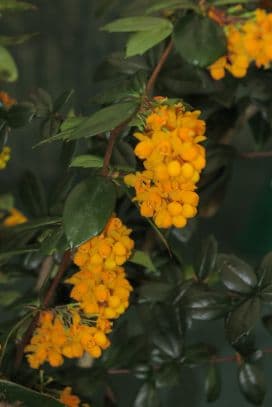
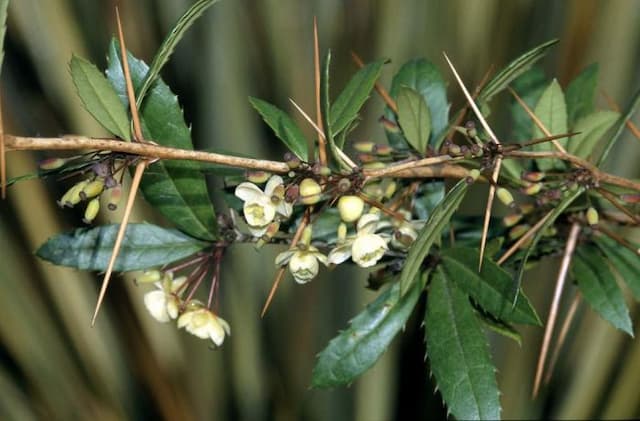
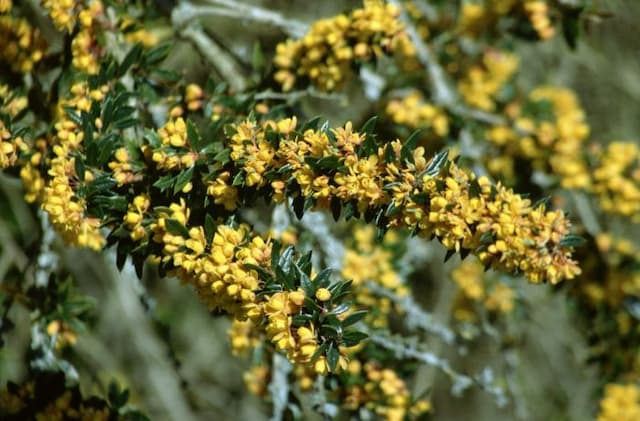
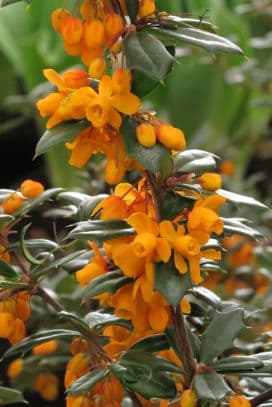
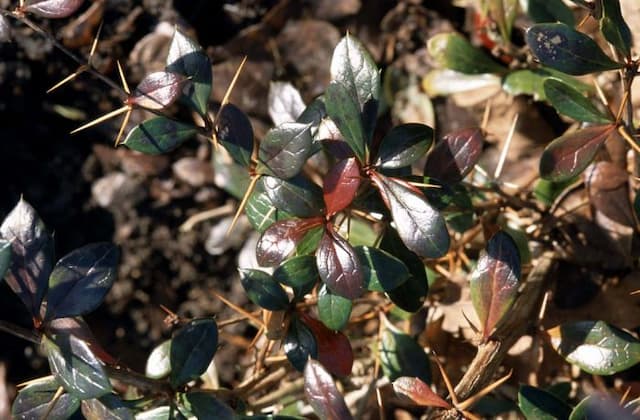


![Japanese barberry [Bonanza Gold]](/_next/image?url=https%3A%2F%2Fplants-admin.emdemapps.com%2Fimages%2Fplants%2F%2Fimages%2F604b5385e413f.png&w=640&q=75)

